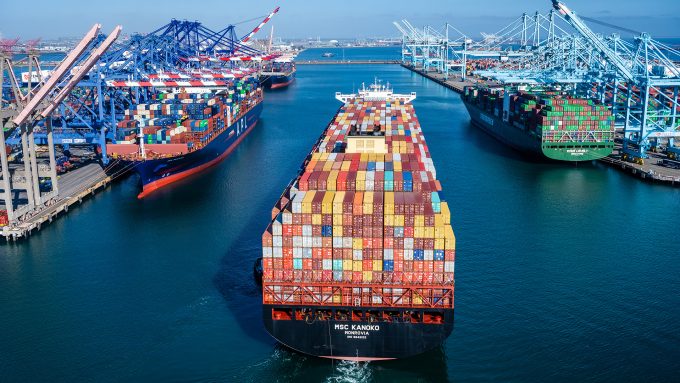

Pier-300-channel-aerial Port of Los Angeles.
According to the latest McCown Report US west coast ports saw a 22% decline in container imports in April, compared to the record volumes of the previous year, to 812,611 teu, as economic woes and the protracted labour negotiations continued to take a toll on throughput at the Pacific ports.
In fact Gene Seroka, executive director at the Port of Los Angeles said last week that terminals at the port were running at just 70% of their regular capacity, which he blamed on the economy for 15% of the slack, while 15% he estimated was due to concerns over industrial action shifting the routing of orders to east and Gulf Coast ports.
Mr Seroka said that it would “take months” to convince shippers to return to using west coast ports once a new Labour deal is struck, but on that subject he was, “optimistic that we’ll hear good news soon” suggesting that, “we are on the doorstep of a tentative agreement”.
Elsewhere, the top US east coast ports saw a 20% dip in container imports to 887,950 teu, to take the total of import containers handled by the Top 10 US ports to 1.7m teu in April representing a 21% fall on the same month of the previous year.
Moreover, in further evidence of the drop in US imports from the elevated demand of the previous year, the McCown Report’s three-month trailing figure for inbound containers sits at 4,689,195 teu, down 26.7%.
On the west coast Los Angeles recorded the biggest decline last month, down 24.7% to 343,688 teu, while on the east coast the Port of Charlston’s imports fell by 28.2% to 101,024 teu.
Los Angeles just about held onto its top ranking in April, but the Port of New York & New Jersey is getting close to usurping it from its long-held premiere status recording 331,563 teu of container imports last month.
Nevertheless, Mr Seroka is optimistic of a better second half of the year.
“If economic conditions improve and we get a labour deal in place, that will definitely help drive our volume,” said Mr Seroka.
“Yet even with economic uncertainty I expect an improvement compared to the first half of the year.
“We are prepared for the next cargo surge whenever it comes,” said Mr Seroka.
However, the executive said that there was “still much more work to do” in reducing inventories, “until we start seeing a more normal cadence of cargo coming across the transpacific”.
Meanwhile, container spot rates on the tradelane have been relatively stable over the past few weeks after giving up much of the mid-April carrier GRIs earlier, and now the shipping lines are looking to introduce a fresh GRI that they hope will help them to finalise some of the outstanding contract negotiations.
Indeed, The Loadstar understands that several carriers, including Zim and CMA CGM are proposing to implement GRIs of up to $1,000 per 40 ft on the transpacific effective 1 June.
Notwithstanding the boost to their contract negotiations carriers are keen to see freight rates pushed up before the start of the traditional peak season in July.







